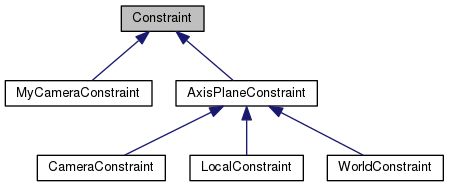An interface class for Frame constraints. More...

Public Member Functions | |
| virtual | ~Constraint () |
| Virtual destructor. More... | |
| virtual void | constrainRotation (Quaternion &rotation, Frame *const frame) |
Filters the rotation applied to the frame. More... | |
| virtual void | constrainTranslation (Vec &translation, Frame *const frame) |
Filters the translation applied to the frame. More... | |
Detailed Description
An interface class for Frame constraints.
This class defines the interface for the Constraints that can be applied to a Frame to limit its motion. Use Frame::setConstraint() to associate a Constraint to a Frame (default is a NULL Frame::constraint()).
How does it work ?
The Constraint acts as a filter on the translation and rotation Frame increments. constrainTranslation() and constrainRotation() should be overloaded to specify the constraint behavior: the desired displacement is given as a parameter that can optionally be modified.
Here is how the Frame::translate() and Frame::rotate() methods use the Constraint:
The default behavior of constrainTranslation() and constrainRotation() is empty (meaning no filtering).
The Frame which uses the Constraint is passed as a parameter to the constrainTranslation() and constrainRotation() methods, so that they can have access to its current state (mainly Frame::position() and Frame::orientation()). It is not const for versatility reasons, but directly modifying it should be avoided.
- Attention
- Frame::setTranslation(), Frame::setRotation() and similar methods will actually indeed set the frame position and orientation, without taking the constraint into account. Use the WithConstraint versions of these methods to enforce the Constraint.
Implemented Constraints
Classical axial and plane Constraints are provided for convenience: see the LocalConstraint, WorldConstraint and CameraConstraint classes' documentations.
Try the constrainedFrame and constrainedCamera examples for an illustration.
Creating new Constraints
The implementation of a new Constraint class simply consists in overloading the filtering methods:
Note that the translation (resp. rotation) parameter passed to constrainTranslation() (resp. constrainRotation()) is expressed in the local Frame coordinate system. Here, we use the Frame::transformOf() and Frame::inverseTransformOf() method to convert it to and from the world coordinate system.
Combined constraints can easily be achieved by creating a new class that applies the different constraint filters:
Definition at line 117 of file constraint.h.
Constructor & Destructor Documentation
|
inlinevirtual |
Member Function Documentation
|
inlinevirtual |
Filters the rotation applied to the frame.
This default implementation is empty (no filtering).
Overload this method in your own Constraint class to define a new rotation constraint. See constrainTranslation() for details.
Use Frame::inverseTransformOf() on the rotation Quaternion::axis() to express rotation in the world coordinate system if needed.
Reimplemented in CameraConstraint, WorldConstraint, LocalConstraint, and AxisPlaneConstraint.
Definition at line 142 of file constraint.h.
Referenced by Frame::rotate(), Frame::rotateAroundPoint(), Frame::setRotationWithConstraint(), and Frame::setTranslationAndRotationWithConstraint().
Filters the translation applied to the frame.
This default implementation is empty (no filtering).
Overload this method in your own Constraint class to define a new translation constraint. frame is the Frame to which is applied the translation. It is not defined const, but you should refrain from directly changing its value in the constraint. Use its Frame::position() and update the translation accordingly instead.
translation is expressed in local frame coordinate system. Use Frame::inverseTransformOf() to express it in the world coordinate system if needed.
Reimplemented in MyCameraConstraint, CameraConstraint, WorldConstraint, LocalConstraint, and AxisPlaneConstraint.
Definition at line 133 of file constraint.h.
Referenced by Frame::rotateAroundPoint(), Frame::setTranslationAndRotationWithConstraint(), Frame::setTranslationWithConstraint(), and Frame::translate().
The documentation for this class was generated from the following file:
- worldsim/3rdParts/qglviewer/constraint.h